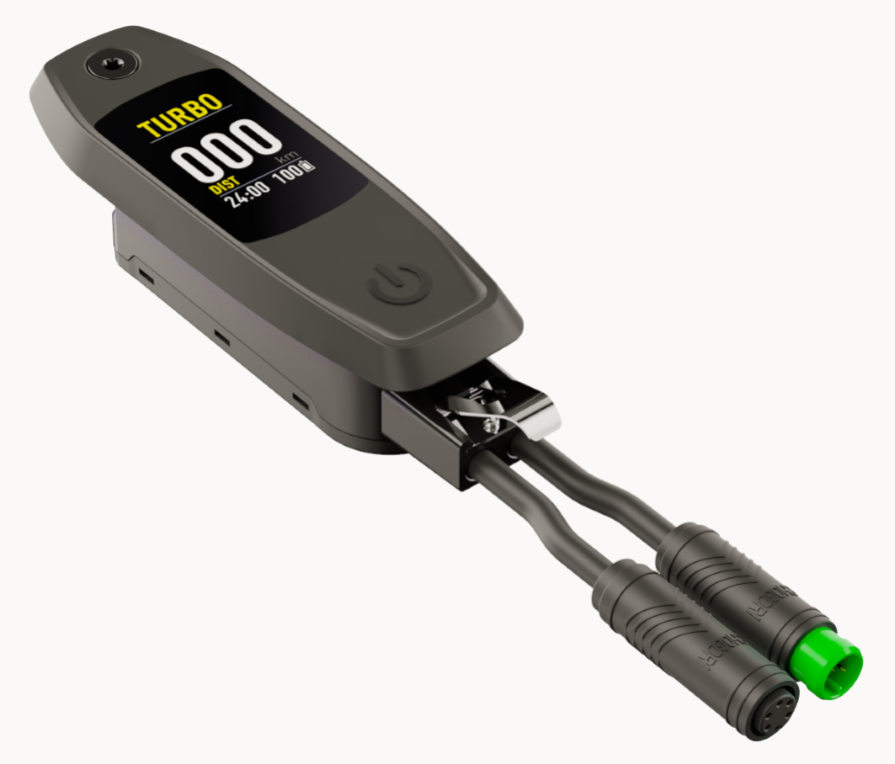MasterMind Displays: Key features & differentiators
| CRITERION | TCU | MASTERMIND TCU |
| Naming & reference | Marketing name: TCU Internal name: TCU1  | Marketing name: MasterMind TCU Internal name: TCU2  |
| Key features | – LED panel, static display – 10 bars and three circle lines to show state-of-charge, modes and errors – Master for bike-control, on/off, etc. – Mode cycling via display button and wired remote – ANT+/Bluetooth (Mission Control, etc.) – Micro USB cable connection (Turbo Studio) – Back-up battery: CR 1620, replaceable – Event/Error log | – Color TFT screen, customizable – Master for bike-control, on/off, etc. – Mode cycling only via wired remote – ANT+/Bluetooth (Mission Control, etc.) – USB-C cable connection (Turbo Studio) – Pressure sensor for barometric measurement (elevation should be calibrated before a ride through the display setup menu) – Back-up battery: fully integrated (kept charged via system)Event/Error log – Event/Error log |
| Internal back up battery | Important difference to MasterMind TCU: The bike powers on with a longer button-press even if the internal coin cell is empty or missing. Details: – Replaceable CR 1620 back-up battery – If battery is low/empty, TCU shows an error pattern – Empty battery does not cause functional issues (bike can still be started with a longer button-press, internal log is not lost, etc.) – Effect of empty coin cell: only time/clock will be lost, but will be re-set automatically when connecting to MC App after replacing | Important difference to TCU: The back-up battery needs to be sufficiently charged for the bike to power on. Details: The Back-up battery is fully integrated and not replaceable (it is designed to last as long or longer than the expected bike life time). When connecting the bike directly to Turbo Studio, the MasterMind TCU will receive power via the USB-A to USB-C connection and the bike will power on by itself. If the bike does not power-on during unboxing, connect the display to Turbo Studio or to a USB port to start the bike and to charge the internal battery. The Internal battery is always charged when the bike is turned on. Fully charging the internal MasterMind TCU battery will take up to 1.5 hours (either through riding the bike or through connecting the display via a USB-C cable to a power source). A fully charged internal battery will allow the bike to be powered on during 1 year without charging it or powering the bike on; different storage temperatures and conditions will affect this time span; moderate storage temperatures preserve the state of charge better |
| Service part | S216800009 – ELE TURBO CONNECT UNIT DISPLAY (A1.2) WITH GITEKI MARK – Display is not an aftermarket item | S216800020 – ELE TURBO CONNECT UNIT 2 – Display is not an aftermarket item |
| Service note | For service reasons, a MasterMind TCU can be replaced by a TCU, but not vice versa. Always run Turbo Studio (Component Change) and available updates to ensure intended functionality | For service reasons, a MasterMind TCU can be replaced by a TCU, but not vice versa. |
| Connection to Turbo Studio | USB-A to Micro USB Note: A bike with a TCU needs to be turned on manually when connected to Turbo Studio | USB-A to USB-C Note: A bike with a MasterMind TCU will turn on automatically when connected to Turbo Studio |
| Updating during unboxing | Must be updated through Turbo Studio during unboxing for latest firmware and intended functionality/features. | Must be updated through Turbo Studio during unboxing for latest firmware, intended functionality/features, correct speed limit and Mission Control connectivity. |
| Tune menu | Fully applicable in Mission Control and in Turbo Studio | In Turbo Studio, only core Tune values can be customized (Support, Peak Power, etc.). Screen customization is exclusively manageable through Mission Control |
| Screen customisation | Not available (apart from Stealth Mode) | – Exclusive via Mission Control – Can be done through any Mission Control account Note: Any custom screen settings are (re-) applied through the latest Mission Control connection. Example: User A customizes the screen, then User B connects with his Mission Control account. Result: screen settings of User B over-write settings of User A because the custom settings are tied to the respective Mission Control account. |
| Diagnostics | 100 event logs held locally and sent via Advanced Diagnostics in Mission Control Note: diagnostics are not uploaded automatically | 100 event logs held locally and uploaded automatically via Mission Control or via Advanced Diagnostics Note: despite the auto-upload function, it is advisable to upload diagnostics through Mission Control before looking at the Event Log |
| Component change | Should be completed through Turbo Studio to install latest firmware and to ensure intended functionality/features | Must be completed through Turbo Studio, otherwise bike will not connect to Mission Control and only latest firmware ensures intended functionality/features |